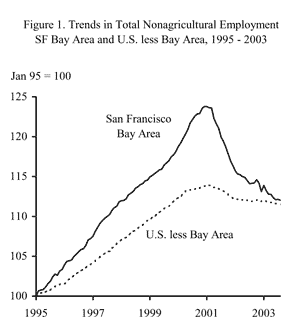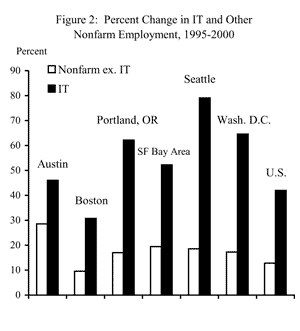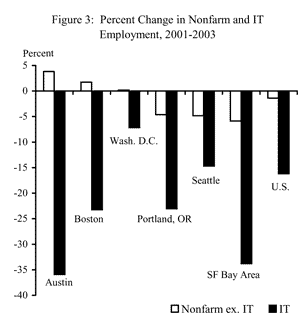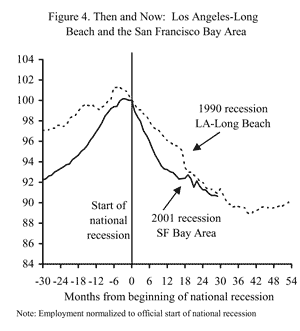After being the quintessential darling of the nation’s economy, the San Francisco Bay Area has been battered by the information technology (IT) downturn; nearly one in ten jobs in the Bay Area has disappeared since the peak of late 2000, and half of those were in the IT sector. This Economic Letter explores the sources of the boom and bust in the Bay Area and puts the region’s recent contraction in the context of the U.S. and other regional IT centers.
After being the quintessential darling of the nation’s economy, the San Francisco Bay Area has been battered by the information technology (IT) downturn; nearly one in ten jobs in the Bay Area has disappeared since the peak of late 2000, and half of those were in the IT sector. This Economic Letter explores the sources of the boom and bust in the Bay Area and puts the region’s recent contraction in the context of the U.S. and other regional IT centers. This Letter also compares the current episode of weakness in the Bay Area to the long and deep recession in the Los Angeles area in the early 1990s.
The findings highlight the good and the bad of being one of the nation’s premiere IT centers. The region’s focus on innovation and technology made it a primary beneficiary of the national IT investment run-up during the latter half of the 1990s. Unfortunately, it also made the Bay Area vulnerable to the brunt of the IT downturn, resulting in some of the most pronounced job losses in the nation and all but eliminating the sizeable employment growth advantage the region accumulated during the expansion. This seismic shift in Bay Area fortunes is akin to the downturn in the Los Angeles area following the collapse of the defense industry in the early 1990s, but with an important difference: while the LA economy saw a more permanent realignment of industries, the Bay Area remains a leading IT center.
Bay Area employment trends in context

The boom. During the latter half of the 1990s, the Bay Area was one of the nation’s leading job creating regions. As seen in Figure 1 between 1995 and late 2000, employment in the Bay Area grew 24%, almost twice as fast as the rest of the nation. The IT (manufacturing and services) sector played a large role in this run-up; employment in IT industries increased 67% and directly accounted for nearly 30% of all of the job growth in the Bay Area.
The Bay Area wasn’t the only IT center to reap the benefits of the high-tech boom. Figure 2 shows the percent increase in IT employment and nonfarm employment less IT between 1995 and late 2000 for five other MSAs also known for their high-tech prowess: Austin, Boston, Portland, Seattle, and Washington, D.C. In all of these MSAs except Boston, IT employment growth surpassed the national average of 42%. In Seattle, IT employment increased a phenomenal 79%, boosted especially by a doubling of employment in the software publishing industry. Washington, D.C., also saw exceptional IT employment growth (62%), benefiting from large gains in the telecommunications sector and in the scientific research and development services industries.

In terms of employment growth outside of IT, again, all the MSAs except Boston outperformed the national average, which was 13%; Austin came in first with a 29% gain, and the Bay Area came in second with a 19% gain.
The bust. As the IT bubble deflated, so did the Bay Area economy. Since hitting a peak in December 2000, total nonagricultural employment in the Bay Area has plummeted by 350,000 jobs, or 9.5% (data are through August), far exceeding the 2.0% decline in employment recorded nationally; about half of these lost jobs were in the IT sector. As seen in Figure 1, these losses have all but eliminated the employment gains accumulated during the IT boom, returning Bay Area payrolls to early 1998 levels.
The IT slump hit Bay Area employment hard for two reasons: employment in the IT sector fell faster than in the other five MSAs, and, compounding that, the Bay Area relied more heavily on the IT sector than did the other MSAs. For instance, IT employment accounted for about 13.5% of all jobs in the Bay Area in 2000, compared to nearly 10% of all jobs in Boston and Washington, D.C., and about 7.5% for the other three MSAs in 2000. The national average was just 4.5%.

Figure 3 shows the change in IT employment and in nonfarm employment less IT for the six MSAs from late 2000 to August 2003. IT employment in the Bay Area fell 34%, the second highest of the listed MSAs, and more than double the national average of 16%. IT employment in the Bay Area is broadbased, and the decline in employment was substantial in all sectors: IT manufacturing (31%), software (28%), telecommunications (32%), and Internet service providers, web search portals, and data processing centers (50%).
Austin also experienced a severe IT cutback, with employment falling by more than a third. In contrast to the Bay Area, Austin’s IT sector is made up almost entirely of manufacturing. Even Dell, the nation’s most successful computer manufacturer, has shed jobs in the Austin area to cut costs. Further, two semiconductor fabrication plants in Austin owned by AMD closed recently. Portland and Boston also fared worse than the national average, with Portland losing about 25% of its IT manufacturing jobs and Boston losing 40% of its employment in the computer systems design segment.
Two MSAs whose IT sectors have held up relatively well are Washington, D.C., and Seattle. Seattle’s IT sector was actually helped by a 9% increase in the software publishing industry, helping offset losses in other IT areas.
Changes in employment outside of IT vary across the MSAs and, on the surface, appear not to be strongly related to the declines in the IT sector. For instance, the Bay Area had the sharpest decline in IT employment and the sharpest decline in employment outside of IT. However, in Austin, where the decline in IT employment was similar to the Bay Area, employment growth outside of IT has been strong. No doubt the decline in the IT industry adversely affected employment in other Bay Area industries, but many other factors influenced employment as well; for example, the Bay Area was relatively more exposed to the decline in business and international travel that depressed the airline and hotel industries over the past several years.
Déjà vu—early 1990s all over again?
For many, the IT-driven decline in Bay Area employment in recent years stirs memories of the recession led by the aerospace industry in Los Angeles-Long Beach (LA-LB) during the early 1990s. That downturn, driven by permanent restructuring in the defense industry, was one of the longest and deepest in California history and the worst in the nation during the period. In the end, the LA-LB employment recession lasted 44 months and eliminated nearly 513,500 jobs (12.3% of peak employment).
To get a sense of how the recent episode in the Bay Area compares, Figure 4 displays employment trends in the Bay Area over the past several years and employment trends in LA-LB during the early 1990s. The employment data are normalized to equal 100 at the start of the respective national recessions (March 2001 for the Bay Area and July 1990 for LA-LB). Although the Bay Area downturn is only about 32 months old, as measured by employment losses, it has been similar to the LA-LB episode. The Bay Area already has lost nearly 10% of its peak employment, and indications of a turnaround in the job figures in the near term are few.

Although the declines in employment in the Bay Area over the past couple of years match those of LA-LB in the early 1990s, there are some important differences. First, as Figure 4 indicates, employment in the Bay Area expanded far faster during the two years leading up to the downturn than it did in LA-LB. As a result, the recent downturn in the Bay Area has eroded only about two years’ worth of job gains, returning Bay Area payrolls to early 1998 levels. In contrast, the downturn in LA-LB removed more than five years of accumulated job growth, returning employment to its 1985 level. Second, data on personal income for California and home price appreciation for the Bay Area suggest that income and wealth losses have been smaller during the recent Bay Area contraction than they were in LA-LB in the early 1990s. Finally, while the loss of aerospace jobs in LA-LB reflected permanent restructuring in the defense industry, especially in Southern California, the bust in IT investment appears to have been only a temporary pullback following the late 1990s IT spending frenzy. With IT investment already on the rise in the U.S., recovery in the Bay Area depends on whether the region has been able to maintain its position as one of the nation’s leading centers for IT production and service.
While it still is too early to tell how quickly the Bay Area will recover the jobs lost during the downturn, several factors bode well for it to remain a focal point for innovation and technology. First, the Bay Area’s key resources including its universities, research labs, and skilled workforce, remain intact. Second, data through the second quarter of this year show the region continues to receive a significant share of venture capital in a wide range of fields, including the emerging biotech industry; although venture capital funding plunged during the downturn, the latest data show that it has started to increase again. Third, several key IT companies headquartered in the Bay Area have seen their revenues increasing. Finally, national investment in IT goods has been increasing and is expected to continue to do so.
Mary Daly
Research Advisor
Mark Doms
Senior Economist
Opinions expressed in FRBSF Economic Letter do not necessarily reflect the views of the management of the Federal Reserve Bank of San Francisco or of the Board of Governors of the Federal Reserve System. This publication is edited by Anita Todd and Karen Barnes. Permission to reprint portions of articles or whole articles must be obtained in writing. Please send editorial comments and requests for reprint permission to research.library@sf.frb.org
